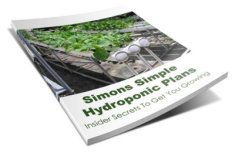If you’re gone through one of those catalogues offered by a top lighting seller, you’ll realize it is almost too difficult to choose the right hydroponic grow lights for your hydroponic project. A wide array of lights is available, so adopt a hydroponic lighting system that works, both inside your house and in the garden.
Successful systems use a combination of timers, bulbs, ballasts, and light shades. However, you’re never really ready to buy these hydroponic lights unless you come prepared with guidelines that show you how and where you get the best cheap artificial lights.
The only three systems you’ll ever need are:
T5 Fluorescent Lamps
One of the cheapest lights currently available in the market, fluorescent lamps are ideally suited for small projects. Switch on these fluorescent lamps for around 16 hours a day in an indoor setup.
Your initial project can be an ornamental houseplant, leafy vegetables like spinach and lettuce, or you may have a panel of hydroponic grow lights to stimulate growth in seedlings, clones, or cuttings.
As these lights can be used around the house, it’s a good idea to start off your project with T5 fluorescent lamps, then shift to the more powerful HID lamps, especially if you plan on growing tomatoes and flowers. Fluorescent lamps offer light over a wide area, so you can actually have individual pots with seedlings and cuttings lined up with a lettuce raft.
Practical Tips
- Use this as a ready reckoner to decide on the number of T5 fluorescent lamps you’ll need for your hydroponic project. Each lamp is 4 feet in length and effectively distributes light over 2 ft.² of the hydroponic working area. In other words, you’ll have to increase a lamp to produce every additional 2 ft.² of lighting. Example: 4 lamps are needed to cover a 2X4 ft.2 lettuce raft
- Opt for 40W of light output per ft.2 of hydroponic working area.
- Arrange these hydroponic grow lights at a height of 4 to 6 inches above the plants for optimum results. Fluorescent lamps give off very little heat, so the plants will not get damaged.
High Intensity Discharge (HID) Grow Lights
Ideally suited for the flowering and fruiting phases of any hydroponic project, these high intensity discharge lamps, also known as HID hydroponic lights, are generally used in commercial setups like greenhouses and in large indoor gardening areas.
These lamps are quite expensive and emit considerable amounts of heat, so choose the right types of flowers and plants for your indoor hydroponic garden. For example, medicinal herbs require heat as well as intense light. These herbs grow well when HID lighting systems are used.
How HID lighting systems are assembled
- Modern systems employ two types of HID lights – metal halide (MH) and high pressure sodium (HPS) lights. While the MS light is ideally suited for small vegetable gardens during the growth phases, the no more powerful HPS light is needed for the fruiting and flowering stages of a vegetable bed. Most projects require 400W to 600W lamps.
- Remote ballast – You’ll need a remote ballast to match the light output of these lamps. Place it away from the flowering bed, so it does not get damp.
- Reflector Hood – Cone-shaped or parabolic reflector hoods are recommended for maximum light coverage.
- Timer – Automate the switching on and off of these hydroponic grow lights with a heavy duty grounded timer. Set timings for multiple lamps with the same timer.
Practical Tips
- Go in for a four-sided rectangular hood for maximum coverage.
- For smaller projects, the cheap MH lights are sufficient to fulfill the overall lighting requirements. These lights last for around 15 to 24 months.
- Over larger projects, use the more powerful HPS lamp that lasts for around five years. Note: If the effective light spectrum and heat is needed for your project, replace these HPS lamps after two years.
- Use external ballasts to reduce the weight of light fixtures.
- Consider the use of a grow light mover, which essentially is a railing mounted on the ceiling to focus light on specific areas of your project. A motor is attached to this light fixture that helps move it in the linear plane.
Light-Emitting Diode (LED) Glow Lights
LED lamps were earlier not considered for hydroponic projects; however, with technological advances, LED hydroponic grow lights are now used for high-power applications including hydroponic gardens. These LED lamps come in different shapes and sizes, so a complete array of lamps can be arranged to form a custom-made panel.
Practical tips
- Inexpensive and lightweight, LED lamps can actually replace a costly HID lamp at a fraction of the cost.
- Refer to All System DIY case studies to see how these lamps produce optimum results.
- Choose a high-end LED lamp to match the light spectrum offered by the more powerful HID lamp.
- Used with reflective materials like titanium white wall paint, LED hydroponic grow lights can diffuse light appreciably around the required areas.



